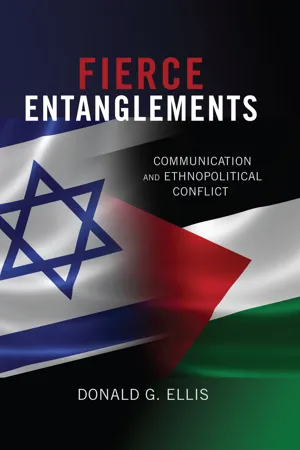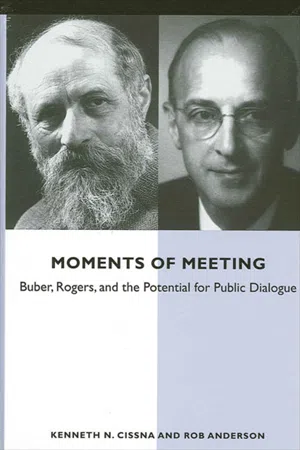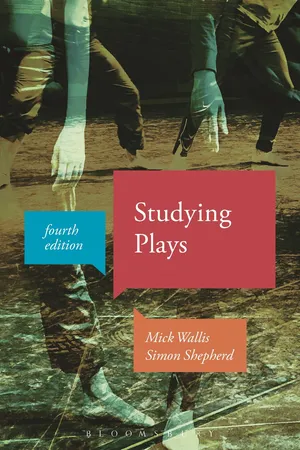Literature
Dialogue
Dialogue in literature refers to the conversation between characters, often used to reveal their thoughts, emotions, and relationships. It serves to advance the plot, develop characters, and create a sense of immediacy and authenticity in the narrative. Well-crafted dialogue can also convey subtext, conflict, and thematic elements, enriching the overall storytelling experience.
Written by Perlego with AI-assistance
Related key terms
1 of 5
4 Key excerpts on "Dialogue"
- eBook - PDF
Fierce Entanglements
Communication and Ethnopolitical Conflict
- Donald G. Ellis(Author)
- 2015(Publication Date)
5. Dialogue As we will see throughout the development of this chapter, Dialogue is complex and used in a variety of ways, but its most essential meaning concerns conversations where individuals seek to gain better understanding of the oth- er. It often refers to communication that explores concerns, needs, and mis- understanding and is conducted in a space outside “normal” conversation. It is commonplace to have participants in the Dialogue set aside time and space which marks off the dialogic communication. In a political sense, Dialogue is used to discuss issues that are typically contentious and in the process un- derstand and incorporate the points of view of others. The fact that people “set aside” time and place for Dialogue is indicative of its unique nature. In this book we will understand Dialogue as conversation pursued by two or more parties for mutual understanding rather than agreement or solutions. Dialogue groups help inform, build consensus, and develop shared values while having a significant impact on the intensity and nature of disagree- ments. It is deliberation, addressed in detail in the next chapter, which is the form of communication best suited for resolving differences and generating solutions. Dialogue and deliberation go hand-in-hand and cannot be fully separated, but each has its own goal. Dialogue is most sharply distinct from debate. Debate is about winning arguments and clashes designed to gain the upper hand. Debate is a zero-sum game; Dialogue focuses on mutual under- standing and learning about the other. Dialogue is different from debate, deliberation, and conflict resolution, but it complements each by serving as the foundation and a prelude to each of these activities. Allport (1954) very early stressed the conditions of contact or the con- ditions of communication most conducive to achieving goals. - eBook - PDF
Christian and Muslim Dialogues
The Religious Uses of a Literary Form in the Early Islamic Middle East
- David Bertaina(Author)
- 2011(Publication Date)
- Gorgias Press(Publisher)
The last category of Dialogue is the focus of this study. 29 See Karel van der Toorn, “The Ancient Near Eastern Literary Dialogue as a Vehicle of Critical Reflection,” in Dispute Poems and Dialogues in the Ancient and Mediaeval Near East , 59-75, especially 64. 20 C HRISTIAN AND M USLIM D IALOGUES Greek philosophical Dialogues. In contrast to the use of Dialogues to advance a story plot, literary Dialogues presented the plot as a way to advance characters’ ideas. For Greek writers such as Plato, the form was an intellectual display of rational argumentation be-tween the questioner and respondent. Based on the assumptions of objectivity, rationality, and teaching authority, the Dialogue form was meant to persuade and convince others of specific truths, offer apologetics, and present intelligible accounts of their worldview. Using dialectic and rhetoric, Dialogues were meant to mimic human conversation while leading their audience toward a specific intellec-tual goal. 30 Ancient authors adopted the Dialogue genre because of the beneficial characteristics of its form. Dialogues solve a problem through the process of questions and answers in a discussion. The Dialogue form created a relationship between characters, such as a master and disciple link. Ancient Dialogue literature portrayed real-istic participants, as conversation partners needed identities. Only then could the author negotiate the path of his own identity with that of the discussants. In many Dialogues, a contest would ensue between the characters. They engaged in debate using polite or ad-versarial rhetoric to argue against one another or to consider inno-vative answers to a problem. 31 As the champion of the author’s Dialogue, the master was in control of the discussion with the disci-ple. At the end of the Dialogue, the merits of the competing claims were weighed against one another, and the Dialogue came to a con-clusion. - eBook - PDF
Moments of Meeting
Buber, Rogers, and the Potential for Public Dialogue
- Kenneth N. Cissna, Rob Anderson(Authors)
- 2012(Publication Date)
- SUNY Press(Publisher)
Finally, we close the chapter by justifying a series of critical (anti)methods that guided our research choices at var- ious moments along the way, and which we would suggest for other re- searchers contemplating similar work. THE QUALITY OF Dialogue AS RHETORICAL ACCOMPLISHMENT The term “Dialogue” can commonly suggest a wide variety of mean- ings in everyday life. Scriptwriters produce Dialogue that actors inter- pret; that is, Dialogue in one sense often refers simply to what is said on stage, and, by extension, in everyday conversations. A second sense flows from the first; Dialogue is sometimes considered to be any com- municative event in which the partners engage in relatively equal back-and-forth interchange. Some politicians are likely to say of a given meeting with a diplomat, for example, that he or she was “open to Dialogue”—by which they mean that the other person didn’t mo- nopolize or monologize the occasion. Finally, and also linked to the in- terchange sense of Dialogue, some social scientists use the term simply to refer to the conversation’s essential characteristic of alternating turns (Riegel, 1979). However, thanks to Buber and others, the human sciences have re- covered a philosophical sense of Dialogue as a particular quality of human relating, one that sparks in those moments when communica- tors most fully realize their relationships. We will look more closely at Buber’s Dialogue in the next chapter, as he is one of the key players in our exploration. But, in brief, Buber claimed that human living is not contained within private human psyches, but emerges from “the be- tween,” the relational arena in which humans meet and confront each other as separate persons. Buber distrusted the modern tendency to psy- chologize existence, and discounted the feelings and cognitions of an individual mind as basic criteria by which to judge communication. - eBook - PDF
- Mick Wallis, Simon Shepherd(Authors)
- 2018(Publication Date)
- Bloomsbury Academic(Publisher)
Dynamics In this subsection we are concerned with the push-and-pull of Dialogue – both between characters and between the stage and the auditorium. The dynamics of exchange Even with simple characters we are drawn into the cut and thrust of an argument, or the verbal embraces of young love, or the stunned response to bad news. Regardless of characters or the details of the fiction, let us say that Dialogue demands its own empathy – we easily imagine ourselves in such a situation; these exchanges are ones that could be ours; it might be our own story. Such exchanges most certainly will have happened in our own real story. Drama plugs into our most basic desires, fears and wants. Just as the clown slipping on the banana skin makes our stomach turn, so the threat from the outsider makes us look over our own shoulder. All of us feel threatened in some way, and theatre stimulates that fear and many other basic feelings. We easily – automatically – imagine ourselves as part of the situation shaped by the Dialogue. As we wrote on p. 31, ‘Look out behind you!’ So while Dialogue constructs character and action, and we can become good at describing this, we also need to show how local bits of Dialogue involve the audience in the cut and thrust of position-taking, challenge, triumph, defeat; the securities of meeting and embrace; the joys of recovering lost ones; the thrill of verbal abuse and profanity; the feelings of isolation but also relief when confessing guilt. Then we are going much further in describing how the play as a whole works on the audience. This aspect of the Dialogue can best be explored by making diagrams (we have sketched ours in Figure 3.1): this is especially handy for directors.
Index pages curate the most relevant extracts from our library of academic textbooks. They’ve been created using an in-house natural language model (NLM), each adding context and meaning to key research topics.



